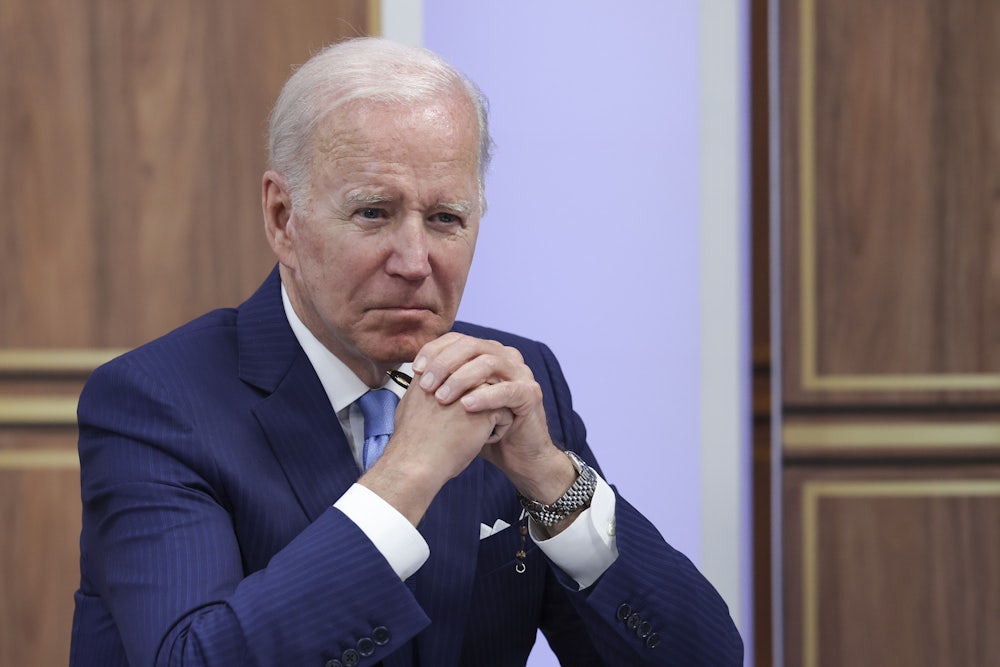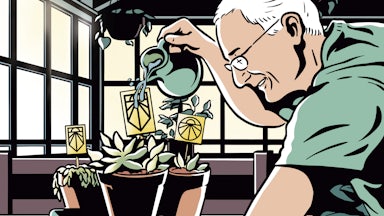This is the week when Joe Biden’s normally opaque White House revealed its inner angst. An NBC News article titled “Inside a White House Adrift” describes Biden’s mood with verbs such as “bristling” and “rattled.” The Washington Post, in a story about White House panic over inflation, recounts that the president has “complained for weeks” and “privately grumbled” over the administration’s laggard response to higher prices.
With dispirited Democrats braced for losing the House and maybe the Senate in November, a relevant question is whether the current moment of political torment was brought on by easily avoidable miscues by Biden or whether it was inevitable. It’s tempting to begin with Biden’s dismal 41 percent approval rating. Biden dipped below the 50 percent mark last August and has been mired in the low 40s since Halloween. But low presidential approval ratings have been the norm for almost two decades. Aside from the heady first months of Barack Obama’s time in office, no president has been over 60 percent in the Gallup Poll since early 2004 when the Iraq War turned into “Mission Not Accomplished” for George W. Bush. In fact, beginning with Bush’s second term, the approval ratings of all presidents have consistently been in negative territory.
The reality that all twenty-first century presidents have been unpopular provides scant consolation for Democratic candidates who feel saddled with Biden’s mixed record in office. But what about the reality of the past year and a half? In short, how much of this is Biden, and how much is it the excruciating times in which we live? Let’s take them one by one.
Inflation
It is hard to feel comforted when Treasury Secretary Janet Yellen admitted Tuesday in a CNN interview that she “was wrong about the path that inflation would take.” In hindsight, the administration probably should have heeded the prescient early 2021 warnings by former Treasury Secretary Larry Summers that Biden’s ambitious $1.9 trillion stimulus package would magnify the risks of inflation.
But in 2022 political terms, it probably didn’t matter. Inflation in the 19 countries that use the euro is running at more than 8 percent, a rate comparable to that of the United States. Such are the costs of the war in Ukraine, pandemic-era supply chain disruption, skyrocketing energy prices, and the lingering effects of Covid-19 shutdowns. Even if Biden and the Federal Reserve had adopted tight-fisted economic policies from the beginning, America would be still be buffeted by the highest inflation rate since the 1980s. Whether the number was 8 percent or 5 percent—whether gas prices were $4.60 a gallon or $3.80—Republicans would be weaponizing inflation in the midterm elections.
Covid-19
More than anything, Biden was elected as the pandemic president. Yet aside from comparisons with his superspreader predecessor, Biden’s performance has been disappointing. He will be haunted by his buoyant optimism last Fourth of July weekend when he declared at the White House, “We’re closer than ever to declaring our independence from a deadly virus.” Since that speech, nearly 400,000 Americans have died from the virus and more than 25,000 are currently hospitalized with Covid. Biden’s premature victory lap was based on unwarranted faith that the country would widely take advantage of vaccines and follow up with booster shots. While 78 percent of the U.S. have received at least one vaccine dose, only 31 percent have taken a booster, far behind other countries where vaccines are readily available.
Yes, the virus has consistently confounded scientists as new variants keeping altering the equation. But public health officials appointed by Biden—especially Rochelle Walensky, the director of the CDC—have offered inconsistent and confusing guidance to the public. The administration has been slow to deliver on promises to make the Covid drug Paxlovid easily available. And alarmingly, a Democratic Congress cannot even find a way forward to approve a paltry $10 billion in needed Covid funding.
But the pandemic is a global phenomenon—and no country, even with exceptionally competent leadership, has avoided the ravages of the virus. America has endured unnecessarily large numbers of deaths and serious illness because of resistance to vaccination and a live-free-or-die hatred of masking. No one this side of Tucker Carlson could argue that Biden has handled the virus worse than Trump, yet over half of Covid deaths in the U.S. have taken place since he took office.
In Biden’s defense, the pandemic had become a symbol of political polarization by Inauguration Day. No matter how passionately Biden pleaded for vaccinations, a large chunk of the Republic Party has denied the reality of the continuing public health emergency. A mid-May Axios/Ipsos survey found that an unhealthy majority of Republicans believe that the government has spent too much on Covid and that the pandemic is over. It is lamentable that the Biden administration surrendered to the inevitable when, in April, a Donald Trump–appointed federal district court judge—whom the American Bar Association had rated as “unqualified”—overturned the mask requirement for interstate travel. But in the face of GOP denial and anti-vaxxer wackiness, any federal mandate was fast becoming as unenforceable as Prohibition.
Afghanistan
No one is talking about the abject, heart-breaking American retreat from Kabul as a 2022 voting issue, but last August marked the moment when Biden’s approval rating permanently headed into minus territory. There was no easy way to end a two-decade war—despite the public largely favoring a withdrawal—but the disastrous manner in which it took place wasn’t inevitable. What matters in the long term for Biden’s domestic standing is that Afghanistan—more than anything else—destroyed Biden’s image of competence. Since Biden came to office radiating less natural charisma than any president since George H.W. Bush, the failure of planning and execution in Afghanistan undermined the strongest rationale for his presidency.
When a president’s performance raises questions about the administration’s competence, it is usually difficult to recover. George W. Bush’s “Brownie, you’re doing a heck of a job” blundering during Hurricane Katrina colored his entire second term. That may partially explain why Biden’s adroit handling of the war in Ukraine has not prompted detectable movement in his approval rating. The other factor is that foreign policy, unless there are major American casualties, rarely dominates politics for more than a few weeks.
Overpromising
Biden and the Democrats are also paying a major political price for hubris. Despite his narrow 2020 victory and a 50–50 Senate, Biden came into office modeling himself on Franklin Roosevelt. By wildly inflating what was possible in an era of Joe Manchin and the Senate filibuster, Biden is still stymied by his failure to deliver anything on his $3.5 trillion Build Back Better bill. Despite his supposed mastery of the Senate, Biden’s naïvely upbeat forecasts that a deal with Manchin and the inscrutable Kyrsten Sinema was continually around the corner only compounded the problem of unrealistic expectations.
The result has been a wave of cynicism on the part of Democratic voters. No polling number is more electorally ominous than the finding in a recent Reuters/Ipsos survey that only 72 percent of Democrats approve of Biden’s performance in office. This prompts the obvious fear that too many Democrats and Democratic-leaning independents will decide that voting doesn’t matter because guns won’t be regulated and the polar ice caps are still melting. This underscores the potential consequences of Biden—a president who should have been able to count votes—overpromising and under-delivering.
Underselling
By raising left-wing hopes that his first two years in office, with its supposed $3.5 trillion spending on everything from climate change to childcare subsidies, would equal the New Deal, Biden managed to obscure all that he actually accomplished, even with Mitch McConnell as at times the de facto Senate majority leader, thanks to the filibuster and Democrats’ near-invisible majority. For all its inflationary impact, the initial $1.9 trillion stimulus has given kept the unemployment rate well under 4 percent, and its now-expired provision expanding the childcare tax credit cut the monthly child poverty rate by 30 percent. The historic $1 trillion infrastructure bill passed the Senate with, yes, McConnell’s support. And the Senate has been approving liberal federal judges at a near-record pace, thanks to the party loyalty shown by, yes, Manchin and Sinema. But boasting about the stunningly low unemployment rate and the gratifying strength of the Ukrainian resistance (backed by American weaponry) will only get you so far in politics. What matters to voters is what they feel—such as gas prices and baby formula shortages—rather than political messaging from the White House.
The 2022 elections—with Covid untamed and global inflation soaring—were always going to be tough for the Democrats. But the undue optimism from the White House about what is possible with a 50–50 Senate has made a difficult political terrain even more treacherous to navigate. The only hope is that Biden will recognize the problems that stem from his own performance in office rather than just blaming the unfairness of life and the failures of Democratic sloganeering.










